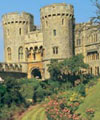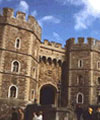|
AN OFFTOLONDON.COM TRAVELLER'S GUIDE FEATURE
Hampton Court Palace
and Tudor Banquets
 Windsor Castle, Stonehenge and Georgian Bath11 hours
Windsor Castle, Stonehenge and Georgian Bath11 hours - Don't leave London without experiencing this best selling tour to Windsor Castle, Stonehenge and Georgian Bath. Your day trip includes entrance to the Roman Baths and Pump Rooms, Stonehenge and Windsor Castle. Book now to avoid disappointment!
Starting from USD $113.10 per personClick for details
 Windsor Castle and Runnymede5 hours Windsor Castle and Runnymede5 hours - Windsor Castle is the largest inhabited castle in the world and has been home to all England's Monarchs since 1078. Runnymede - where King John was forced to seal the Magna Carta in June 1215. Starting from USD $63.94 per personClick for details
|
Royal preoccupation with Italian Renaissance classicism and baroque during the 17th and 18th centuries ennobled London. We are the beneficiaries. Sadly however the fabled Tudor palaces at Bridewell, Whitehall, Greenwich, Richmond and Nonsuch were torn down during the great Stuart building spree as mediaeval old Gothic made way for Rennaissance new classic with considerable help from the 1666 Great Fire of London.
Hampton Court is London's sole surviving Tudor palace, bar parts of St. James's. Thanks to its distance from the city centre, it is often overlooked by visitors. This is a pity because it is a true Tudor gem with Henry VIII's magnificent hammer-beam roofed Great Hall, Chapel, Royal apartments, and the vast warren of kitchens designed to cope with the 30 course banquets served up to King and over 1,200 courtiers.
A visit to these kitchens will open your eyes to the gluttonous feasting habits of the Tudor monarch and his household. We already have a clear picture from the Eltham Statutes, a series of ordinances drawn up in 1526 by Cardinal Wolsey, Henry VIII's Lord Chancellor, for the better running of the King's household. Two years later, Wolsey tactfully handed Henry the keys to Hampton Court Palace, his newly completed Cardinal's residence, in an unsuccessful effort to stave off political oblivion and disgrace following his debacle over the King's divorce from the hapless Catherine of Aragon.
As a preamble, the Statutes laid down a ruling that master cooks be paid to clothe the scullions. They had hitherto run about naked, (and slept), in the 
Medieval drawings - Medieval German cookbook |
appalling heat of the open fire kitchens, or wore particularly vile and soiled garments. Wolsey's own Hampton Court household had amounted to 1,000 persons in support of his lavish lifestyle and entertaining as England's prelate. Not to be outdone by his former advisor, Henry VIII enlarged Wolsey's kitchen plan to 50 rooms; a vast 36,000 square feet of food-preparation capacity.
We see from the Eltham ordinances that two courses should be served at the table of "the King's Majesty and the Queen's Grace" for dinner. For a first remove, the kitchens served up 15 dishes from a choice of bread and soup, beef, venison, red deer, mutton, swan (alternating with goose or stork), capon, coney and carp. The remove was completed with a custard or fritters. This was followed by the second remove of nine dishes. These were composed of jelly, spiced wine and almond cream, followed by a selection from practically every bird in the sky - pheasants, herons, bitterns, shovelards, partridges, quails, cocks, plovers, gulls, pigeons, larks, pullets, and chickens. To this was added lamb, kid, rabbit, venison, and tarts. Supper was a variation on dinner, with the addition of a blancmange pudding, butter, eggs and perhaps quinces or pippins in season.
During Lent, on Fridays and on meatless days, a 'lighter' fare was set before the King. His first course of a meagre 15 dishes was taken from bread and soup, ling, eels or lampreys, pike, salmon (which ran up the River Thames in Tudor times), whiting, haddock, mullet or bass, sea-bream or sole, conger, carp, trout, crabs, lobster, porpoise or seal (which counted as fish in those days), custard, tart, fritters and fruit. The second course comprised nine dishes from a menu of another soup, sturgeon, bream, tench, perch, eels, lampreys, salmon roes, crayfish, shrimps, tart, fritters, fruit, baked pippins, oranges, butter and eggs. Saltwater fish was brought up the Thames to the palace in barrels packed with seaweed.
The King might order everything from these menus. The King's entourage fared scarcely less expansively. The Lord Chamberlain's Hampton Court Palace table was entitled to two courses of ten and six dishes for dinner, and seven and four dishes for supper. And so the list of dish allowances carries on down to the end of the line where the maids, servants, porters and children had to exist on two meat dishes for dinner, (beef and mutton), and two for supper (beef and veal). Leftovers found their way, by custom of centuries dating back to the banquets of William the Conqueror in his Great Hall at Westminster, to the poor at the gate.
These Royal menus enshrined in the Eltham Statutes are notable for their high-protein content and lack of green vegetables, prompting some medical historians to wonder whether Henry VIII suffered from scurvy, (among other ailments), in his later years. Needless to say, such gargantuan royal meals served up in the Great Hall required prodigious quantities of home-brewed beer, 
Henry VIII |
ale, and wine from Burgundy and the Rhineland to wash down these vast quantities of food. Six hundred barrels of alcohol were consumed each year at Hampton Court.
English Heritage offer weekend courses in Tudor cooking during 2006 in the Palace kitchens to budding Clarissa Dickson-Wrights who wish to create such arcane delights as the 'Peacock Royal' or stuffed Boar's Head, as carved at Henry VIII's table on the 1542 Midsummer's Day Feast of St. John the Baptist. By then, the 50-year-old King was probably past such gourmandising pleasures. He was obese, gout-ridden, jaundiced, ulcerated, paranoid and single, having executed his fifth wife, 20-year-old Catherine Howard, four months previously. His youthful Merry England of joyful jousting, feasting and libidinous dalliance, when he was described as "the handsomest prince in Europe", were but a royal memory.
The Tudor age of sumptuous royal feasting in Hampton Court's Great Hall flared briefly to final brilliance in 1546, when the King feted the French ambassador and 1,500 retainers for a week, but was not to survive his death the following year. It was not until the Restoration of Charles II in 1660, however, that servants and officers of the Royal Household finally lost their feudal right to the King's meat stemming from the custom begun by William the Conqueror 600 years earlier. From then on, they were paid a wage in lieu of meat at the king's table, and Royal kitchens and the Great Halls they supplied went into a terminal decline in importance. Menus for today's royal banquets given by The Queen at Buckingham Palace and Windsor Castle are a pale shade of the gargantuan feasts of yesteryear.
Burlington Bertie's Travel Tips
Hampton Court Palace
Venue: Hampton Court Palace, East Molesey, Surrey ,KT8 9AU.
Getting there: The Palace is in outer London, on
the A308 road near the A3, M3 and M25. Parking is available. From the M25, take exit 12 (then the A308)
or exit 15 (then the A312). Parking available. Regular rail service London/Waterloo - Hampton Court, (30 minutes). Nearest Underground: Richmond, with bus connections to the gate. Summer river service Westminster Pier - Palace quay.
Tickets: Online booking. Adults £12.30, (Concessions). Disabled visitors admitted at standard rate but accompanying carer comes free. Disabled Facilities. Open daily bar 24 - 26 December. Check times online.

Hampton Court Guides. Photo by Mark |
Further Information: Hampton Court Palace is a fascinating Tudor/ Stuart/Georgian mix of the intimate and grandiose spanning 11 reigns from Henry VIII - George II. Free tours and presentations by costumed guides, give a lively and entertaining account of contemporary Palace life and history. Enjoy a light Tudor repast in Queen Elizabeth I's Privy Kitchen before exploring the 60 acres of Palace gardens. The famous maze, the Great Vine and the newly restored Privy Garden await you. Take tea in the Garden Tiltyard Tea Rooms.
Many events take place each year here, including the annual June Music Festival, the July RHS Flower Show, the above mentioned cookery courses, the September grape harvest and a host of costumed Christmas activities and events. Check online and choose your visiting date accordingly
Visitors may attend daily services in the Chapel Royal. Details online.
Accommodation: Stay within Hampton Court Palace itself in a Tudor apartment run by The Landmark Trust. Rent by the week. Book up to a year ahead to avoid disappointment.
Toodle oo! Burlington Bertie
If you have a question, contact us and we will do our best to provide answers.
© offtolondon.com All rights reserved.
|
